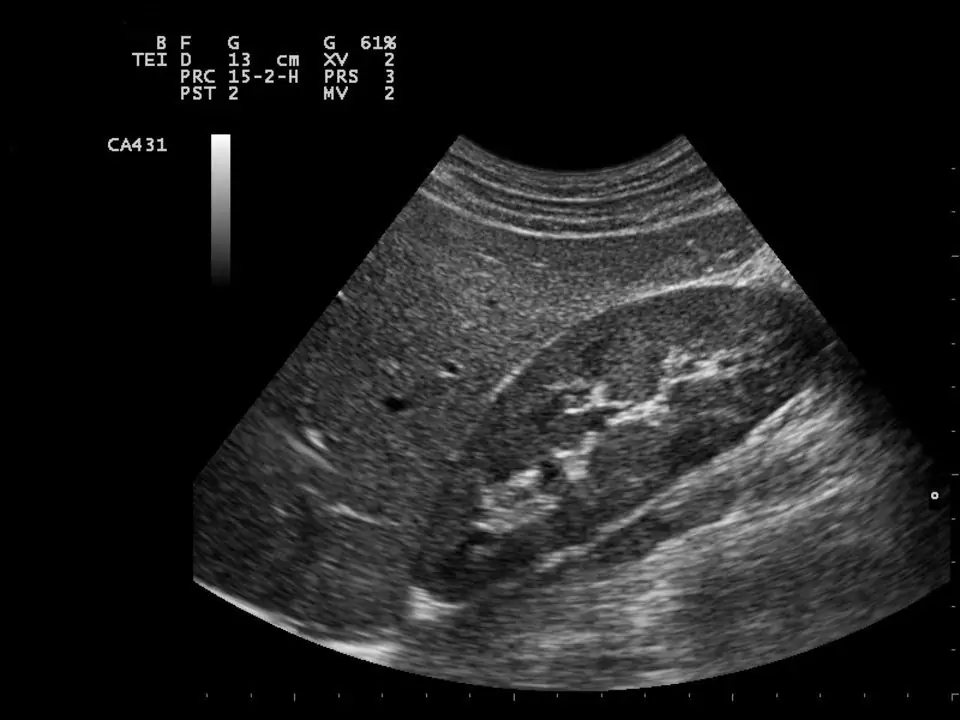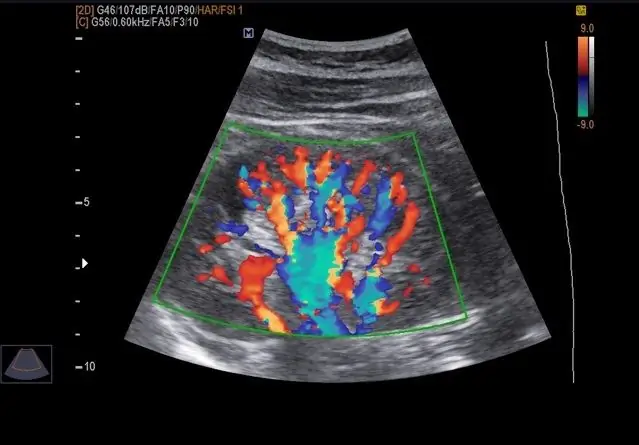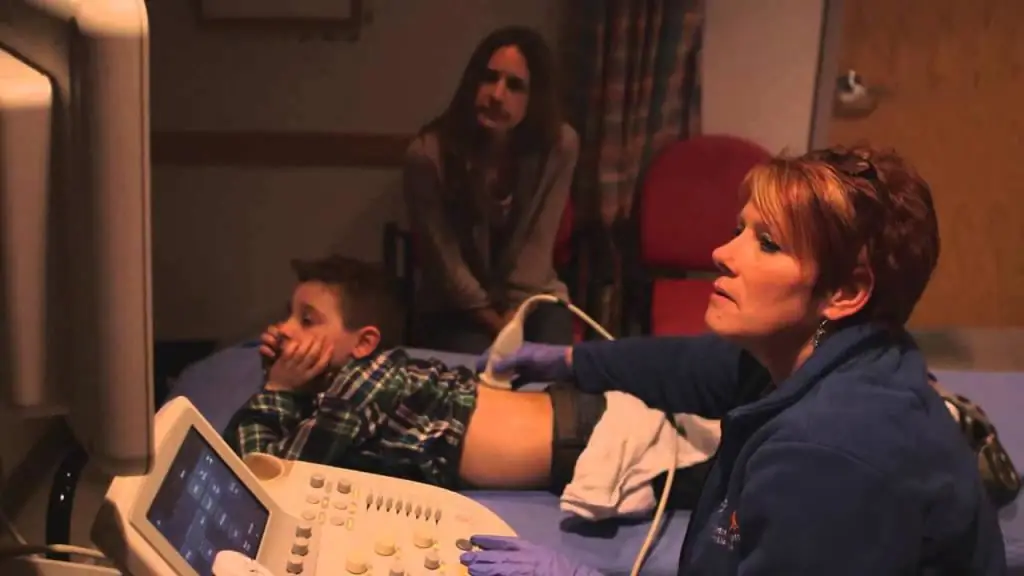- Author Curtis Blomfield [email protected].
- Public 2023-12-16 20:44.
- Last modified 2025-01-23 17:01.
The body takes nutrients from food and converts them into energy. After the necessary food enters the body, metabolic waste remains in the intestines and is absorbed into the bloodstream.
The kidneys and urinary system contain chemicals (electrolytes) such as potassium and sodium, as well as water. They remove metabolites called urea from the blood.
Urea is produced when protein-containing foods such as meat, poultry and some vegetables are broken down in the body. It is carried into the bloodstream and then to the kidneys.

The functions of the kidneys are as follows:
- removal of liquid waste from the blood in the form of urine;
- maintaining a stable balance of s alts and other substances in the blood;
- production of erythropoietin, a hormone that promotes the formation of red blood cells;
- adjust blood pressure.
The kidneys remove urea from the blood through tiny filter units called nephrons. Each nephron is made up of a networkformed by small vessels - capillaries called glomeruli and a small renal tubule.
Urea, along with water and other waste materials, forms urine as it passes through the nephrons and through the renal tubules.
What is an ultrasound
Ultrasound diagnostics (ultrasound of the kidneys) is a safe and painless method that is based on the conversion of acoustic waves to create a gray scale (black and white) image of organs, including the kidneys, ureters and bladder. The method is used to estimate the size, shape and location of organs.
Acoustic signals travel at different speeds depending on the type of tissue being examined: they travel fastest through solid (hard) tissue and slowest through air. Air and gases are the main enemies of ultrasound.
Kidneys are a pair of bean-shaped organs located behind the abdomen, just above the waist (the region of the lumbar vertebrae). Moreover, the right kidney is located slightly higher than the left one (the area of the last two thoracic vertebrae). They perform the function of removing waste products of metabolism from the blood and produce urine.
Ureters are thin paired connective tissue tubes that carry urine from the kidneys to the bladder. Urine is produced continuously at all times of the day.
At the time of the examination, the ultrasound scanner transmits ultrasonic signals of different frequencies through a special sensor to the area under study. They are reflected or absorbed by the tissue, and the resulting image is displayed on the monitor. Images in the form of black, grayand white objects reflect the internal structure of the kidneys and related organs. Ultrasound is also used to assess blood flow in the kidneys.
Another type of ultrasound is Doppler scanning, sometimes called duplex, which is used to determine the speed and direction of blood flow in the kidneys, heart, and liver.
Unlike standard ultrasound, acoustic signals can be heard during a Doppler exam.
Indications for ultrasound
Doctors prescribe an ultrasound - examination of the kidneys - for certain complaints and concerns in the area of the kidneys and bladder.
- Intermittent acute low back pain.
- Difficult and painful urination.
- Blood urination.
- Frequent urination in small portions.
- Unable to urinate.

Ultrasound is also recommended for monitoring the condition of existing kidney or bladder problems, for example:
- urolithiasis (urolithiasis);
- kidney stone disease (nephrolithiasis);
- acute and chronic cystitis (bladder inflammation);
- acute and chronic nephritis;
- nephrosclerosis, polycystosis, pyelonephritis, etc.
Ultrasound may also show:
- kidney size;
- signs of injury to the kidneys and bladder;
- developmental anomalies since birth;
- presence of obstruction or stones in the kidneys and bladder;
- complications of urinary tract infections (UTI);
- presence of a cyst or tumor, etc.
Ultrasound can detect any abscesses, foreign bodies, swelling and infections in or around the kidneys. Calculi (stones) of the kidneys and ureters can also be detected using ultrasound.
A normal kidney ultrasound may be done to help position the needles used in the biopsy. It is done to obtain a sample of kidney tissue, to remove fluid from cysts or abscesses, or to place a drainage tube.
Renal ultrasound procedure can also be used to determine the blood flow in the kidneys through the renal arteries and veins. Ultrasound can also be used after transplantation to assess the survival rate of the organ.
Among other conditions, such an ultrasound scan can detect kidney stones, cysts, tumors, congenital anomalies of the renal tract (these are anomalies that were present at birth), prostate problems, the effects of infection and trauma to organs, as well as kidney failure.
There may be other reasons for an ultrasound of the kidneys, in normal and pathological conditions.
Special training
Usually no preparation is required for a kidney ultrasound, although an 8-10-hour fasting diet may be prescribed before the start of the appointment. As a rule, filling of the bladder is required, therefore it is recommended to drink as much water as possible before the examination.
Be sure to tell your doctor about taking any medication - this is very important for the interpretation of subsequent results of the study.
Abdominal pain is the most common indication for a kidney ultrasound scan. However, the doctor may also refer you for the procedure if you are suffering from other symptoms. Or if your recent blood and urine test results are causing concern.
Ultrasound of the bladder and ureters
The bladder is a hollow organ made up of smooth muscle. It stores urine until it is "evacuated" at will by the body.
The most common reason for an ultrasound of the bladder is to check for bladder emptying. The urine that remains in the bladder after urination is measured (“post-void”).

If it stagnates in the bladder for a long time, then problems may arise, for example:
- prostate enlargement (prostate gland in men);
- urethral stricture (narrowing of the urethra);
- organ dysfunction.
Ultrasound of the bladder can also provide information about:
- walls (their thickness, contours, structure);
- diverticula (sacs) of the bladder;
- prostate size;
- stones (uroliths) in the cavity;
- large and small neoplasms (tumors).
During a bladder ultrasound, the ovaries, uterus, or vagina are not examined.
Preparation for an ultrasound of the kidneys and bladder includes a starvation diet (about 10 hours) and a normal bowel movement.
If youdo not check for residual urine after urination, a full bladder is required. You may be asked to drink plenty of water an hour before the exam.
The ultrasound probe is placed between your belly button and your pubic bone. The image is viewed on a monitor and read on the spot. To check your bladder drainage, you will be asked to come out and empty it. When you return, research will resume.
To keep your bladder full, you will need to drink at least 1 liter of fluid 1 hour before your scheduled time. Avoid milk, sodas and alcohol.
If you have an indwelling urinary (urethral) catheter, you need to check with the specialist prior preparation before scanning.
How an ultrasound is done
After preparing for the ultrasound of the kidneys and bladder, the procedure itself will be carried out in a separate room equipped with the necessary equipment. During the procedure, the light in the room is turned off so that the visual structure of the abdominal organs can be clearly seen on the monitor of the machine.

A specially trained ultrasound imaging specialist will apply a clear, warm gel to the desired area of your body. This gel acts as a conductor for the transmission of sound waves to ensure the transducer moves smoothly across the skin and eliminates air between them for better sound transmission. When performing an ultrasound of the kidneys to a child, parents are usually allowed to be nearby to instill in the babyconfidence and support.
You or your child will be asked to remove their top or bottom clothing and lie down on a couch. The technician will then place the transducer over the gel on the selected area of your body. The sensor emits signals of different frequencies (it is selected according to the weight of the patient), and the computer records the absorption or reflection of acoustic waves from the organs. The waves are reflected by the principle of echo and come back to the sensor. The speed at which they return, as well as the volume of the reflected sound wave, are converted into readings of various tissue types.
The computer transforms these audio signals into black and white images, which the ultrasound specialist then analyzes.
What to expect from the study
Ultrasound of the kidneys in women and men is painless. You or your child may feel a slight pressure on your stomach or lower back as the sensor moves across your body. However, you are required to lie still for a while during the procedure in order for the acoustic waves to reach the desired organ more effectively.
The specialist may also ask you to lie down in a different position or hold your breath for a short time.
Getting and interpreting results
Sonography should be performed in all patients with CKD (chronic kidney disease), primarily to recognize advanced, irreversible kidney disease that is not seen on any other additional diagnostics, including biopsy.
On ultrasound, negative signs include reduced kidney size, thin cortical layer, and sometimes cysts. The specialist needs to be careful when settingdiagnosis based solely on kidney size.

Although cortical echogenicity is often increased in CKD, normal echogenicity does not rule out the presence of disease either. Also, echogenicity may increase with reversible (acute) kidney disease. Thus, only a change in this indicator is not a reliable guarantee of the presence of CKD.
Sonography can also identify specific causes of urological and nephrological pathologies such as urethral obstruction, polycystic kidney disease, reflux nephropathy and interstitial nephritis.
Acute kidney failure
While sonography may be useful in acute renal failure, its use should be limited to those patients in whom the cause is unclear or who may have bladder obstruction.
Kidneys are often normal in acute tubular necrosis (ATN), but may be enlarged and/or echogenic.
Kidney enlargement can also occur with other causes of acute kidney failure. Echogenicity is nonspecific and may be elevated for other reasons, including glomerulonephritis and interstitial nephritis.
Cystic kidney disease
Cystic kidney disease is either genetic or acquired. Polycystic disease is the most common genetic mutation type and is characterized by an increase in kidney mass, in addition to multiple cysts. Ultrasound is enough to make a definitive diagnosis.
Pain and hematuria
CT scan is usually recommended to determine the cause of pain and hematuria, but in some cases the diagnosis can be made by ultrasound and this is not unreasonable.
Stones are usually visible, but up to 20% can be missed by a specialist, especially if they are small or inside the ureter.
Thus, CT scanning is more suitable for finding out the causes of acute renal colic.

Carcinoma Screening
Some people are at increased risk of kidney cancer, especially those with previous tumors and kidney transplant patients. Sonography, compared to other methods, may be less sensitive, but it is more accessible and does not involve radiation exposure.
Transplant Nephrology
Sonography is indicated in most cases of acute renal failure due to the only remaining functioning kidney and the frequency of urological complications. Routine surgical use of ureteral stents reduces ureteral obstruction, but bladder dysfunction remains common. Sonography is not used in the diagnosis of acute organ rejection unless it is severe, in which case the allograft will be swollen and echogenic.
However, this picture can also be seen in acute tubular necrosis and nephritis.

Ultrasound specialistwill indicate all the necessary measurements of organs in a special protocol and record a conclusion on the condition of the kidneys, bladder and other organs. Then give it to you or your he althcare provider.
If the results of the study reveal any pathologies or deviations from the norm, then additional examinations (general and biochemical blood tests, urine tests, etc.) are prescribed to clarify the diagnosis.
In an emergency, ultrasound results may be available for a short period of time. Otherwise, they are usually ready within 1-2 days.
In most cases, test results are not released directly to the patient or family.
What can interfere with objective research?
Sometimes, patients neglect to prepare for a study with a kidney ultrasound. Therefore, certain factors or conditions may affect test results. These include, for example, the following factors.
- Severely obese.
- Barium in bowel from recent barium X-ray.
- Intestinal gas.
Risks associated with ultrasound
There are no serious risks associated with ultrasound of the abdomen and kidneys. Ultrasound does not cause discomfort when applying the gel and transducer to the skin.
Unlike X-rays, which can be harmful to the body, ultrasound is completely safe.
Ultrasound can be used during pregnancy and even if you are allergic to contrast dye because itno radiation or contrast agents are used in the process.
Other related procedures that may be performed to evaluate the kidneys include x-ray and computed tomography (CT), magnetic resonance imaging of the kidneys, antegrade pyelogram, intravenous pyelogram, and renal angiogram.
Helping a child
Young children can be afraid of the very prospect of going to an examination and having equipment running. Therefore, before taking your child for a kidney ultrasound, try to explain to him in simple terms how this procedure will be performed and why it is done. Regular conversation can help ease your child's fears.

For example, you can tell your baby that the equipment will just take a picture of him or his kidneys.
Encourage your child to ask questions to the doctor and specialists, try to relax him during the procedure, as muscle tension and trembling can make it difficult to get accurate results.
Babies tend to cry during abdominal and kidney ultrasounds, especially if they are being held, but this will not interfere with the procedure.






